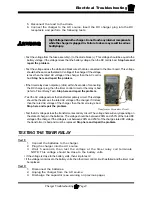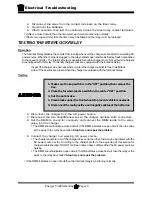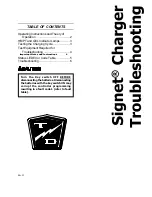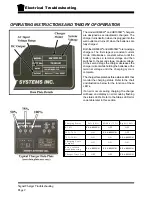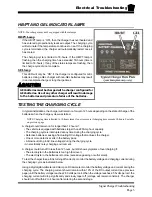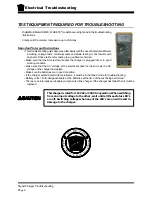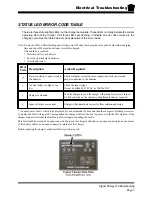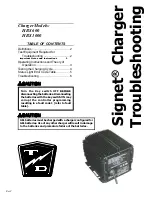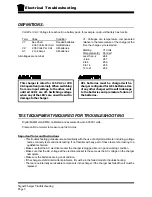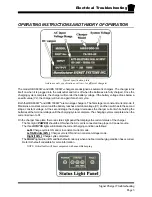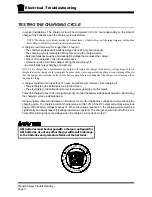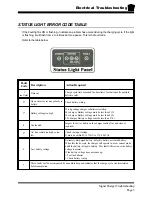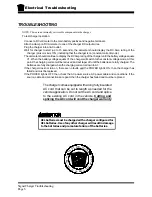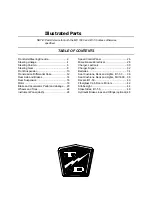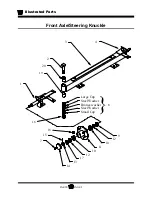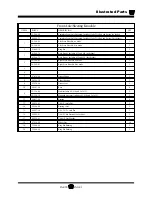
Electrical Troubleshooting
Charger Troubleshooting
Page 10
TESTING THE INTERLOCK RELAY
Operation
The Interlock Relay disables the vehicle from running whenever the charger is connected to a working AC
power source. When the charger is plugged in, the relay contacts open and break the Key Switch connection
to the speed controller. The Interlock Relay is available for built-in chargers only. Not all built-in chargers
are equipped with this relay. To identify chargers that are equipped with the Interlock Relay:
Inspect the charger wire harness where it enters the charger cabinet for two Violet/Black
wires. If these wires are present then the charger is equipped with the Interlock Relay.
Testing
6. Disconnect the charger from the AC power source.
7. Disconnect the two Violet/Black wires at the charger harness knife connectors.
8. Set the DMM to check for continuity and connect the DMM leads to the wires
going into the charger.
•
The DMM should indicate a closed circuit. If the DMM indicates an open circuit, then the relay
or the wires to the relay have failed.
Stop here and repair the problem.
9. Connect the charger to a working AC power source.
•
The charger should turn on. If the charger does not turn on then their may be a problem with the
AC power source or the AC wiring to the charger. Refer to the beginning of this section for
charger troubleshooting. DO NOT continue until you have confirmed that the AC power source is
working.
•
The DMM should indicate an open circuit. If it still indicates a closed circuit, then the relay or the
wires to the relay have failed.
Stop here and repair the problem.
•
If the DMM indicates an open circuit then the interlock relay is functioning normally.
1. Make sure the key-switch is in the “OFF” position, then remove the
key.
2. Place the forward-reverse switch in the center “OFF” position.
3. Set the park brake.
4. Place blocks under the front wheels to prevent vehicle movement.
5. Disconnect the main positive and negative cables at the batteries.
4. Disconnect the wires from the contact terminals on the timer relay.
5. Reconnect the batteries.
6. Wait 5 seconds, then test the continuity across the timer relay contact terminals.
•
If this is a closed circuit, then the timer start up circuit is functioning normally.
•
If there is an open circuit, then the timer relay has failed and the relay must be replaced.
Summary of Contents for B 1-50
Page 2: ......
Page 6: ...TAYLOR DUNN ...
Page 14: ...Model B 1 00 ...
Page 30: ...TAYLOR DUNN ...
Page 36: ...TAYLOR DUNN ...
Page 52: ...TAYLOR DUNN ...
Page 66: ...Maintenance Service and Repair Steering Page 14 Exploded View of Steering Gear ...
Page 90: ...TAYLOR DUNN ...
Page 124: ...TAYLOR DUNN ...
Page 130: ...TAYLOR DUNN ...
Page 161: ...Wire Diagrams ...
Page 194: ...Illustrated Parts PARTS PAGE 10 Front Suspension 4 3 2 1 5 10 6 8 9 7 11 12 ...
Page 202: ...Illustrated Parts PARTS PAGE 18 Motor 2 3 5 6 4 7 8 1 9 10 Armature 9 ...
Page 206: ...Illustrated Parts PARTS PAGE 22 Wheels and Tires Ref wheel hub 1 2 5 assembly 4 3 6 7 8 9 ...
Page 208: ...Illustrated Parts PARTS PAGE 24 Instrument Panel dash ...
Page 217: ...Illustrated Parts PARTS PAGE 33 This page intentionaly left blank ...
Page 220: ...Illustrated Parts PARTS PAGE 36 Seat Cushions Deck and Lights B 1 50 ...
Page 222: ...Illustrated Parts PARTS PAGE 38 Seat Cushions Deck and Lights MX 1600 ...
Page 224: ...Illustrated Parts PARTS PAGE 40 Decals B 1 50 VIEW FROM INSIDE OF COWL 1 2 3 4 5 6 7 8 9 ...
Page 230: ...Illustrated Parts PARTS PAGE 46 Stake Sides B 1 50 1 2 3 4 5 6 7 8 ...














